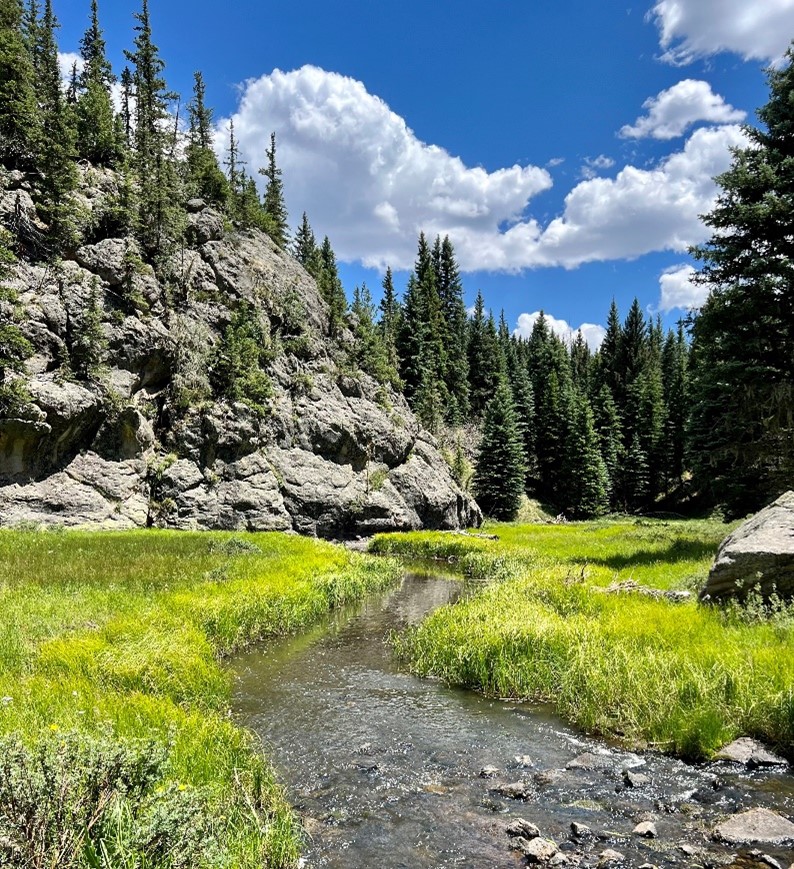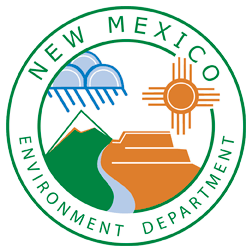
NMED State Permitting Program Development Update
The New Mexico Environment Department (NMED) is actively taking steps to protect the state’s surface waters, which hold cultural, ecological, and economic significance. Currently, New Mexico relies on the Environmental Protection Agency (EPA) and the permitting requirements under the federal Clean Water Act (CWA) to protect its surface waters.
There have been significant reductions in federal protection coverage over the past several decades, in particular protections for intermittent (seasonal flow) and ephemeral (flow only during storms) waters and wetlands that are next to but do not touch jurisdictional waters. This has resulted in major gaps in surface water protection, leaving the majority of New Mexico’s surface waters unprotected by the Clean Water Act.
To better protect our water quality, NMED is pursuing delegation of the federal permitting program from the EPA under the authority of the New Mexico Pollutant Discharge Elimination System (NMPDES) Act. The New Mexico delegated program will be known as the NMPDES Program and will regulate point source discharges into waters of the United States (WOTUS). The NMED Surface Water Quality Bureau (SWQB) is also developing the State Permitting Program under the authority of the New Mexico Water Quality Act to regulate both point source and dredge and fill discharges into surface waters of the State (SWOTS). SWQB is in the process of developing a publicly accessible mapping application to help explain whether waters are under federal (WOTUS) or state (SWOTS) jurisdiction.
SWQB organized a Surface Water Advisory Panel (SWAP), a diverse group of stakeholders that may be affected by the new permitting program. The SWAP was convened in the Fall of 2024 and over the course of several meetings provided feedback, comments, and concerns to the SWQB regarding potential legislation and rules pertaining to a state-led permitting program. Key discussion areas were regulatory scope and program clarity, public engagement and communication, program funding, and sector-specific operational considerations. A summary of the SWAP meeting and key points made can be found in the SWAP Executive Summary, available on the SWQB SWAP Webpage.
NMED has prepared draft surface water permitting rules for the NMPDES Program and State Permitting Program, which includes permits for discharges of dredged and fill material. The NMPDES regulations are included in 20.6.5 NMAC and serve as the foundation for NMED’s application to EPA for NPDES delegation to allow the state to regulate discharges into WOTUS. Meanwhile, the State Permitting Program regulations are amendments to 20.6.2 NMAC and are the framework for the state-led permitting program for discharges into SWOTS. The U.S. Army Corps of Engineers will continue to regulate discharges of dredged and fill materials into WOTUS under the authority of the Clean Water Act.
NMED has received feedback and comments on the draft rules from the Surface Water Advisory Pannel (SWAP) and tribal representatives. NMED has initiated tribal consultation and coordination with New Mexico’s Tribes, Pueblos, and Nations. Although the NMPDES and State programs will not apply to tribal waters, the regulated discharges may impact downstream tribal water quality.
SWQB published the draft rules for public comment in August 2025, and intends to petition the Water Quality Control Commission (WQCC) in December 2025 for a rulemaking hearing, anticipated in Spring 2026.
Surface Water Advisory Panel (SWAP)
NEW Draft Rules
NMED published the Draft New Rule New Mexico Pollution Discharge Elimination System Act, at 20.6.5 NMAC, and Draft Amendments to the State Standards for Ground and Surface Water Protection Rule, at 20.6.2 NMAC, for public review and comment on August 29, 2025.
NMED is accepting comments on the draft rules from August 29, 2025 through October 28, 2025. There are three ways to submit comments: using the Public Comment Portal, sending your comments to the State Permitting Program email at swq.pp@env.nm.gov, or sending written comments to the Surface Water Quality Bureau, ATTN: State Permitting Program, P.O. Box 5469, Santa Fe, NM, 87502.
Documents
Public Review, Draft Amendments to the State Standards for Ground Water and Surface Water Protection Rule, 20.6.2 NMAC and Table of Contents Correction, 20.6.2 NMAC
Public Review, Draft New Rule for New Mexico Pollution Discharge Elimination System Act Rule, 20.6.5 NMAC
Notice of Public Review Draft Comment Period and Informational Meetings English and Spanish (Español)
Public Informational Webinars
NMED hosted three informational webinars to answer questions the public may have regarding the new state permitting program. The purpose of these webinars was to increase awareness to the public about the condition of current regulation for New Mexico’s surface waters and explain how a state-led permitting program will further protect and provide clarity on the proposed rules and the future of surface water regulation in the state.
Informational Webinars Hosted by NMED
Monday, September 22, 2025, at 6:00pm (MDT)
Wednesday, September 24, 2025, at 2:00pm (MDT)
Friday, September 26, 2025, at 10:00am (MDT)
NMED also hosted simulcast sessions for the three webinars as follows:
Monday, September 22, 2025, 6:00-8:00 pm (MDT) in Las Cruces – Dona Ana Community College, 2800 Sonoma Ranch Blvd., DASR Building, Classroom 118E, Las Cruces, NM, 88011
Wednesday, September 24, 2025, 2:00-4:00pm (MDT) in Santa Fe – Santa Fe Public Library Southside Branch, 6599 Jaguar Dr., Santa Fe, NM, 87507
Friday, September 26, 2025, 10:00am-12:00pm (MDT) in Albuquerque – The Gateway Center Auditorium, 5400 Gibson Blvd. SE, Albuquerque, NM, 87108
These simulcast sessions included a video relay of the webinar and the ability for attendees to submit questions in writing to the presenters.
2025 Public Informational Meeting Presentation (PDF)
2025 Public Informational Meeting Presentation Recording (mp4)
2025 Senate Bill 21
Senate Bill 21-Pollutant Discharge Elimination System Act and Senate Bill 22-Water Quality and Pollution were both introduced in the 2025 Legislative Session. The bills were consolidated into Senate Bill 21 and signed into law by Governor Lujan Grisham. Effective June 20th, 2025. Final Version of SB21 can be viewed here.
Further information can be found at: https://www.nmlegis.gov/Legislation/Legislation?Chamber=S&LegType=B&LegNo=21&year=25
2023 New Mexico Surface Water Quality State Permitting Program Survey Results
NMED posted a brief online survey in July 2023 to better understand stakeholders’ perspectives, concerns, and questions about the idea of a state-led permitting program for surface waters. During the survey period, 416 people submitted responses. Respondents included representatives of a wide range of interests, including local governments, industry, oil and gas, environmental organizations, tribes, state and federal agencies, agriculture, irrigation districts, and outdoor recreation. However, most of the people responding to the survey categorized themselves as interested state residents (61.3%).
This early input from stakeholders is helping NMED shape options for the state-led water quality permitting program and develop informational resources to answer questions about the process.
The full “New Mexico State Surface Water Quality Permitting Program Survey: Results and Analysis” report is available here.
Key survey results
- Many respondents (82%) were very supportive of NMED taking the steps needed to develop a state-led surface water quality permitting program for New Mexico. NMED recognizes that the communication channel for alerting people about the survey opportunity – NMED water-focused email lists – reached people who were already signed up to receive water information from NMED. As a result, the people responding to the survey probably already cared a lot about water issues in New Mexico.
- Few respondents (6%) currently have a surface water quality permit. Permittees may be most directly affected by a state-led surface water quality permitting program. The survey results provide some information on how they perceive such a program, but more input from permittees is essential.
- Respondents ranked their top two benefits of a state-led surface water quality permitting program as 1) protection for all important surface waters (82%), and 2) local knowledge of New Mexico’s facilities and waters (75%). In addition to these benefits, many respondents also cited state-led enforcement (46%). These perceived benefits indicate that a state-led permitting program is needed to protect state waters that are no longer covered under the Clean Water Act.
- Most respondents shared concerns and questions about a state-led surface water quality permitting program (72%). Most of their questions and concerns fell under the category of program implementation (60%). These questions and concerns touched on issues such as staffing levels and training; inspection/compliance/enforcement; program funding and costs; permit fees and fines; monitoring; oversight; transparency; efficiency; scope of permit coverage; and effect on Tribal Nations. Regardless of level of support or stakeholder type, respondents wanted more information about the details of a state-led surface water quality permitting program.
Timeline to Implementation
Further Reading and Resources
- America’s Most Endangered Rivers of 2024 featuring New Mexico
- EPA Waters of the United States – Current Definition of the Waters of the United States
- Water Quality Management Plan (WQMP) – Water quality management in New Mexico
- Thornburg Foundation 2021 NM Water Poll – Poll concerning state water resources
- Sackett v. EPA
- Story Map – New Mexico’s Clean Water Trail
- Story Map – Protect New Mexico Water
- Story Map – Wading into Wetlands of New Mexico
Frequently Asked Questions
Surface Water Quality Permitting Program FAQ
In the News
America’s Most Endangered Rivers® report, April 16, 2024
Related articles-
- “Let’s talk about endangered rivers and streams” KUNM, April 15, 2024
- “New Mexico’s rivers are most threatened waterways in US, study finds” The Guardian, April 16, 2024
- “America’s ‘most endangered rivers’ list: Sewage, toxic algae, construction feed the crisis” USA Today, April 16, 2024
- “Photos show wildlife, communities along nation’s ‘most endangered rivers’ for 2024” USA Today, April 16, 2024
- “New Mexico’s rivers named ‘most endangered’ in annual list” KRQE, April 16, 2024
- “US’s most endangered rivers are in New Mexico: Report” The Hill, April 16, 2024
- “Every New Mexico river endangered and vulnerable to contamination, according to national report” Source NM, April 17, 2024
- “American Rivers ranks waters in New Mexico as the most endangered in the country” NM Political Report, April 17, 2024
- “All of New Mexico’s rivers top list for most imperiled in nation” Santa Fe New Mexican, April 22, 2024
- “N.M. Environment Department Wants to Take Over Water Discharge Permits from Feds” Santa Fe New Mexican, Jan 11 2025
- “Western States Step Up to Save Their Wetlands” High Country News, July 1, 2025
Get Involved and Stay Informed
If you would like to be added to our project mailing list, or to contact us with feedback or questions, please send an email to swq.pp@env.nm.gov.
*Surface Water Quality Permitting Program flyers – English & Español



